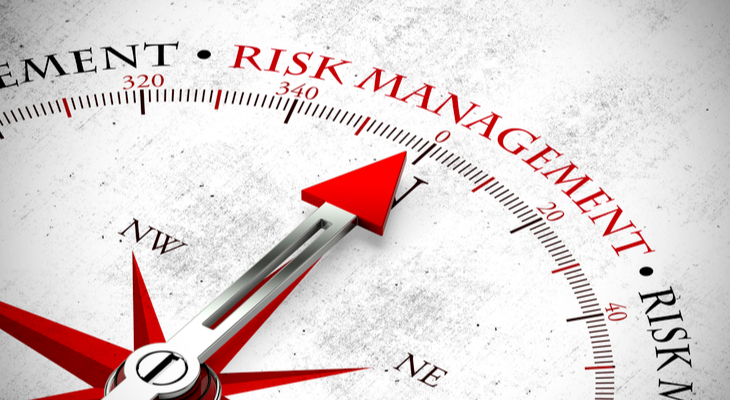What Is Risk Management In Trading + 12 Risk Management Strategies to Try
Discover what risk management in trading means and explore 12 practical strategies to protect your investments and trade smarter.

Risk management in trading is about protecting your hard-earned capital and making it work for you. Think of it as the safety net that lets you take calculated risks without falling flat. Without a grasp of this concept, even the most promising trades can quickly unravel. That’s why understanding risk management should be high on your list when you’re figuring out where to learn trading strategies. This guide is packed with insights to help you preserve your capital and unlock your trading potential.
The funded trading program by AquaFunded is a great way to apply these insights in a real-world setting. It gives you a practical, hands-on approach to trading that can help you grow your skills and maximize profit potential over time.
What Is Risk Management In Trading

Risk management in trading is the art of safeguarding your investments. Think of it as a safety net, those essential steps traders take to minimize losses and protect their money. Without it, you're in trouble. Successful traders use diversification, stop-loss orders, and leverage to reduce risk. They also review trades regularly, especially when they lose, to adapt to changing market conditions.
Related Reading
- How Long Does It Take To Learn Day Trading
- How Long Does It Take To Learn Forex Trading
- How Do You Backtest A Trading Strategy
- Which Trade Is Best For Beginners
- Do You Pay Tax On Forex Trading
- How Many Day Traders Are Successful
- How Much To Start Day Trading
- How To Start Trading As A Student
- Forex Trading Psychology
- How To Do Trading Business
Importance of Risk Management in Trading

Protecting Your Capital and Limiting Losses
Effective risk management shields your trading capital from significant losses. Markets can be unpredictable, with sharp price changes that could wipe out your investment without a solid plan. By setting stop-loss levels and outlining risk parameters, you limit your exposure to these market swings and preserve funds for future trades.
Enhancing Decision-Making
A well-crafted risk management plan supports rational, data-driven decisions. Traders who prioritize risk management are less likely to act on impulse or market rumors. Instead, they use strategic insights grounded in thorough analysis, weighing potential rewards against risks before taking action. This approach reduces emotional trading and keeps decisions rooted in logic.
Building Confidence in Traders
Risk management instills a sense of control in traders. When you have clear risk guidelines, you reduce anxiety and boost confidence. This is crucial during intense market activity, where high-pressure situations can lead to impulsive decisions. Confident traders with robust risk management are more likely to adhere to their strategies and avoid costly mistakes.
Turn your trading skills into substantial profits without risking your capital. AquaFunded’s funded trading program offers access to accounts up to $400K with industry-leading flexibility, no time limits, achievable profit targets, and up to 100% profit split. Join over 42,000 traders who’ve already collected more than $2.9 million in rewards with our 48-hour payment guarantee. Start trading today with instant funding or challenge paths and keep up to 100% of what you earn.
12 Common Risk Management Strategies for Traders

1. Position Sizing: How Much Should You Risk?
Position sizing is crucial for controlling risk. The 1% rule is a classic approach: don't risk more than 1% of your total trading capital on a single trade. If your account is $10,000, for instance, limit your risk to $100 per trade. This method keeps you in the game over the long haul, even after a streak of losses.
2. Stop-Loss Orders: Your Safety Net
Stop-loss orders are indispensable. They automatically close your position when prices hit a certain level, helping you avoid steep losses. Imagine buying a stock at $50 and setting a stop-loss at $48. This limits your loss to $2 per share, ensuring you don’t hang onto a losing trade due to emotional bias.
3. Risk-Reward Ratio: Balancing Risk and Reward
A good risk-reward ratio is essential. Aim for at least 1:2, meaning you risk $1 to gain $2. If you buy a stock at $52 with a stop-loss at $50, your risk is $2 per share. You should aim for at least a $4 gain per share to keep this ratio, allowing winners to cover losers.
4. Diversification: Don’t Put All Eggs in One Basket
Spread your risk across different assets, sectors, or strategies. Instead of putting all your capital in one trade, distribute it across various positions. This approach minimizes the impact of a single loss. For instance, mix stocks, commodities, and currencies to diversify.
5. Hedging: Protecting Against Market Downturns
Hedging involves offsetting positions to reduce risk. If you’re heavily invested in stocks, consider buying put options or shorting an index to protect against downturns. Though hedging can reduce potential gains, it acts as insurance against significant losses.
6. Trailing Stop Orders: Lock in Gains While Limiting Losses
Trailing stop orders move with the market as your trade becomes profitable. If you buy a stock at $50 and set a trailing stop at 5%, the stop-loss adjusts upward as the price rises. If the stock climbs to $55, your stop-loss triggers at $52.25. This helps you ride momentum without risking significant losses.
7. Risk Per Trade Calculation: Know Your Limits
Calculate the maximum potential loss before entering a trade. Determine the difference between your entry price and stop-loss, then multiply by position size. If you buy at $100, set a stop-loss at $95, and purchase 100 shares, your risk is $500. This calculation helps tailor position size within your risk tolerance.
8. Leverage Management: Handle With Care
Leverage can amplify gains and losses. It allows control over a larger position with less capital but increases risk. For example, trading with 10x leverage means a 10% asset drop wipes out your capital. Use leverage cautiously and only when the probability of success is high.
9. Volatility-Based Position Sizing: Adjust for Market Swings
In volatile markets, adjust your position size to mitigate risk. If you usually risk 2% of your capital in low-volatility conditions, reduce it to 1% during high volatility. This prevents significant, unexpected moves from significantly damaging your portfolio.
10. Risk Capital Allocation: Trade Only What You Can Afford to Lose
Use only the portion of your wealth you’re willing to lose without impacting your lifestyle. Trading with risk capital avoids emotional decisions. Never trade with money needed for living expenses, retirement, or emergencies. Allocating risk capital ensures losses don’t jeopardize your financial security.
11. Scenario Analysis and Stress Testing: Prepare for the Worst
Test your strategy under various market conditions before deploying it. Simulate potential environments, including extreme volatility, to see potential gains or losses. This helps identify weaknesses and make adjustments. For example, test how your strategy would perform during a market crash or a period of low liquidity.
12. Emotional Control and Discipline: Keep Cool Under Pressure
Emotional decision-making is a significant trading risk. Traders often react impulsively to market fluctuations driven by fear or greed. Develop emotional control to stick to your strategy. Maintain discipline to adhere to your plan and risk management rules, reducing the risk of catastrophic losses from emotional trades.
7 Tips for Risk Management in Trading

Turbocharge Your Trading with Aqua Funded
Consider harnessing your trading expertise without putting your own money at risk. AquaFunded offers you the opportunity to secure access to accounts up to $400,000 with trading conditions that are as flexible as they come. No rush set your pace with no time limits, reachable profit targets, and a profit split of up to 100%. Join over 42,000 traders globally who've pocketed more than $2.9 million in rewards, all with a 48-hour payment promise. Dive in with instant funding options or showcase your skills through customizable challenges, keeping every cent you earn.
Custom Tailor Your Risk Tolerance
Your risk tolerance is personal, and it’s critical to get it right. Some educators suggest risking 1% to 5% of your trading account per trade. But honestly, it’s about what feels right for you. As you gain confidence in your strategy, you might want to increase your risk percentage, but tread carefully. Trading should either yield a return or leave you with enough capital for your next move. Imagine risking 10% per trade, ten straight losses could wipe you out, and risking just 2%? You’d need to lose 50 trades in a row to zero out your account.
Get Smart About Position Sizing
Once you’ve nailed down your risk tolerance, the next step is sizing up your trades. Balance is key. If you’re risking $100 per trade, going all in with a standard lot of EUR/USD might not be wise. A 100-pip drop could max out your risk. Adjusting position sizes is a smart way to ensure you’re risking the right amount. For instance, a standard lot in forex is 100,000 units, translating to $10 per pip on EUR/USD. A mini lot, on the other hand, is 10,000 units.
Master Your Timing Strategy
Unless you’re using a high-tech trading algorithm, you’ll need to place trades yourself. Markets often operate around the clock, so decide how much time you want to dedicate to trading each day and at what times. This helps you get into the right mindset, which is crucial for managing risk. Waking up at 3 a.m. to trade might not lead to the best decisions. Exit orders can help when you can’t fully focus on the markets, and alerts can notify you when you’re nearing your loss or profit limits.
Steer Clear of Weekend Gaps
Most major markets shut down on Friday afternoon, and prices pause until trading resumes. But markets still move during weekends, and come Monday, you might face a gap. These gaps can leap beyond your stop loss, so your risk management plan should account for them. As Friday winds down, consider closing your position. Gaps aren’t frequent, but they can surprise you. To sidestep them, exit trades before the weekend and perhaps use a gap-trading technique to take advantage.
Stay Alert to News Events
News can shake up forex markets in a big way. Reports on employment, inflation, or central bank decisions can cause significant swings. Like weekend gaps, news can trigger sudden market jumps, affecting stops or targets. Unless you're deliberately taking a strategic risk, approach trading after news events with care.
Keep It Affordable and Sensible
In trading, the rule of thumb is never to invest more than you can afford to lose. Trading is risky, and letting your financial stability hinge on unpredictable markets is unwise. Don’t risk your livelihood, invest intelligently and consistently.
Related Reading
- How To Learn Trading Online
- Is Day Trading Worth It
- Is Day Trading Hard To Learn
- Trading Strategy For Beginners
- Position Trading Strategy
- Profitable Gold Trading Strategy
- Profitable Gold Trading Strategy
- Trading Strategy For Beginners
- Position Trading Strategy
- Option Trading Technical Analysis
Join Our Funded Trading Program Today - Trade with our Capital and Keep up to 100% of the Profit.

Ever wanted to dive into trading without the fear of sinking your cash? AquaFunded makes that dream a reality. With accounts up to $400K, you can start trading right away. There’s no rush, either; there are no time limits, and reasonable profit targets mean you can trade at your own pace. Plus, the profit split can go up to 100%. You get to keep what you earn. More than 42,000 traders have already taken advantage of this, collecting over $2.9 million. And if you want your earnings quickly, AquaFunded's 48-hour payment guarantee has you covered. Whether you jump in with instant funding or test the waters with a customizable challenge, AquaFunded lets you keep up to 100% of what you make.
Related Reading
- Forex Risk Management Tools
- Algorithmic Trading Risk Management
- Best Forex Trading App For Beginners
- What Is Risk Management In Trading
- Trading Risk Management Tools
- Best Day Trading Platform For Beginners
- Best Indicators For Swing Trading
- Day Trading Risk Management
- Best Platform For Day Trading Crypto
- Best Beginner Trading App


